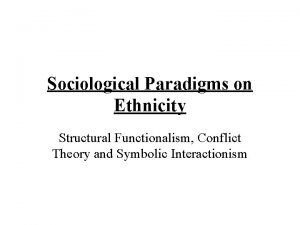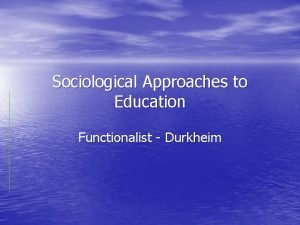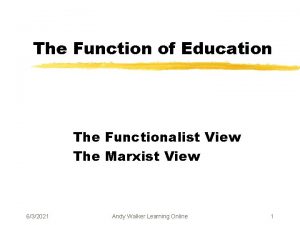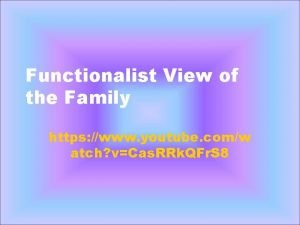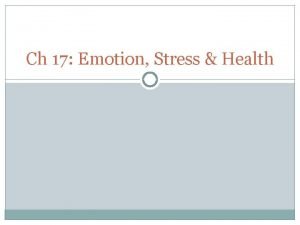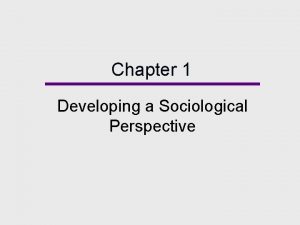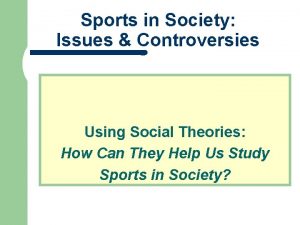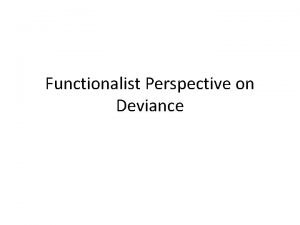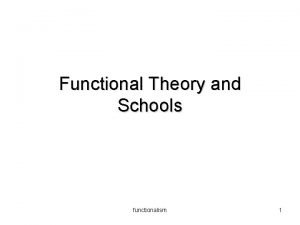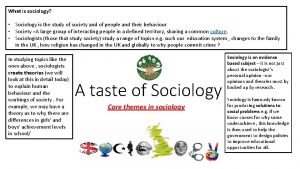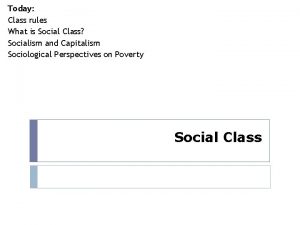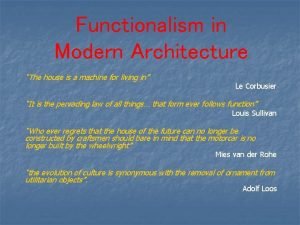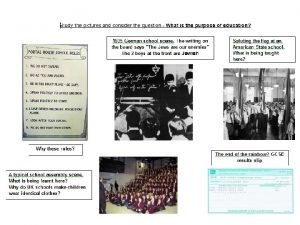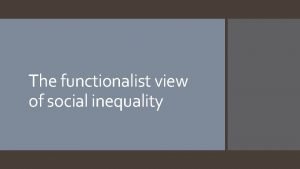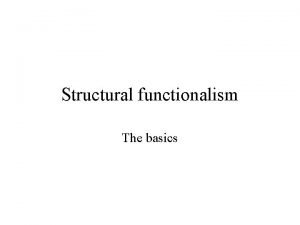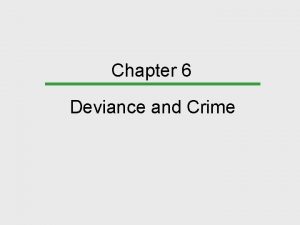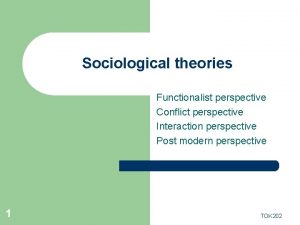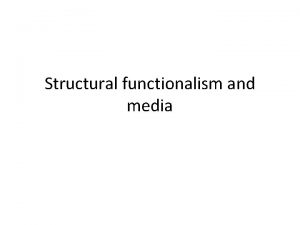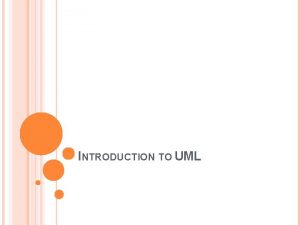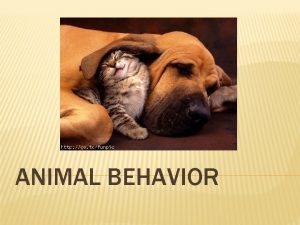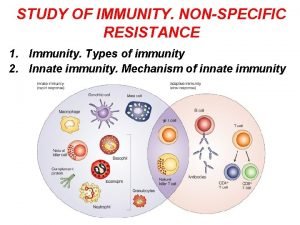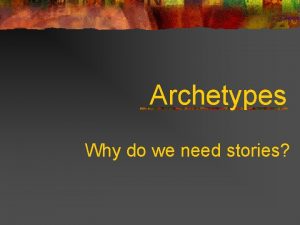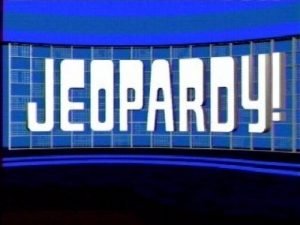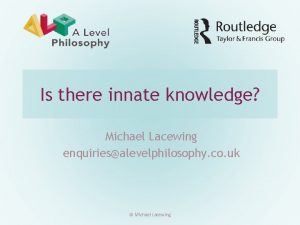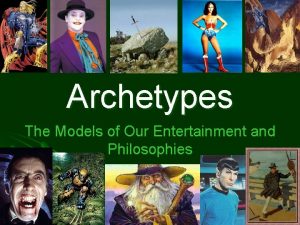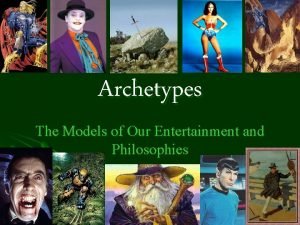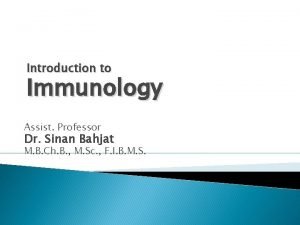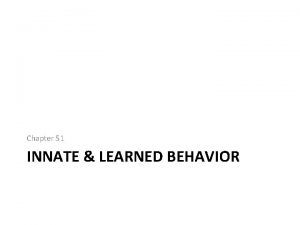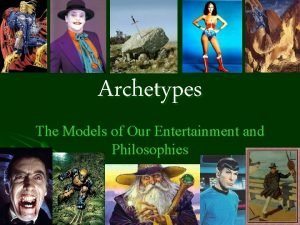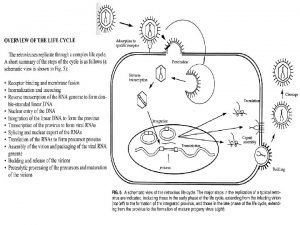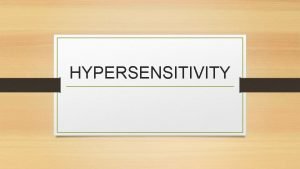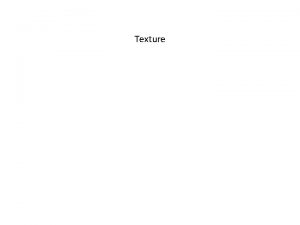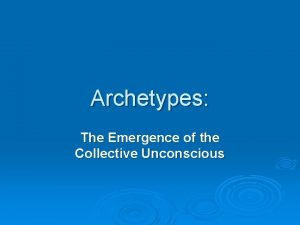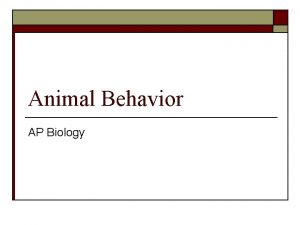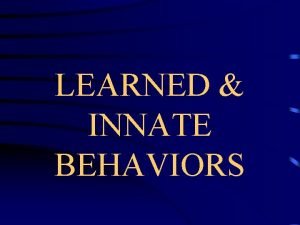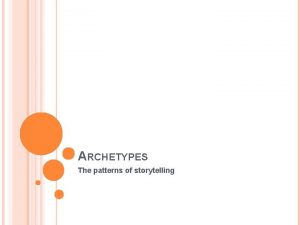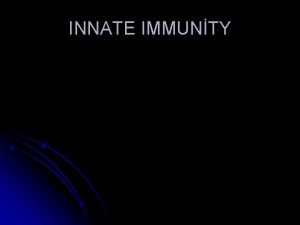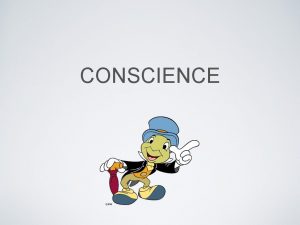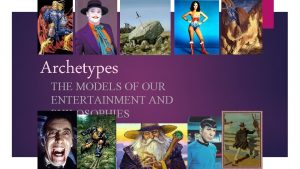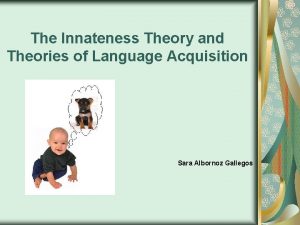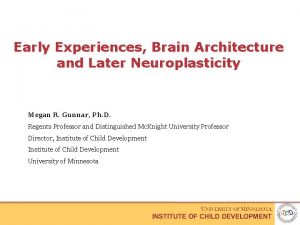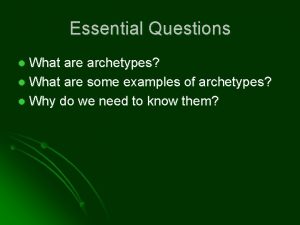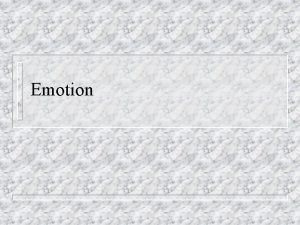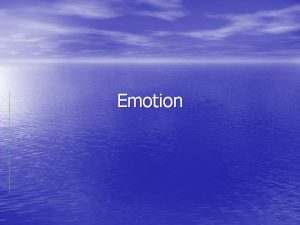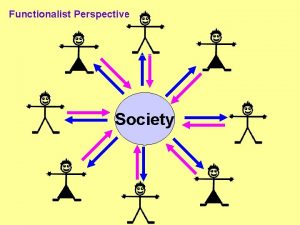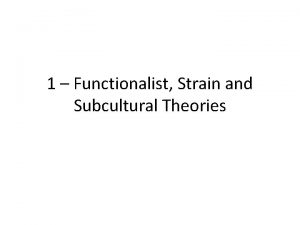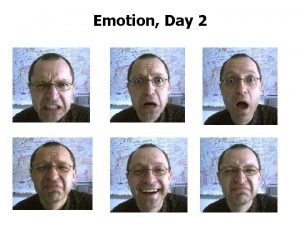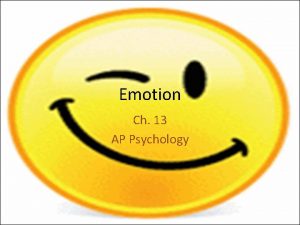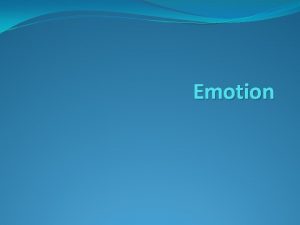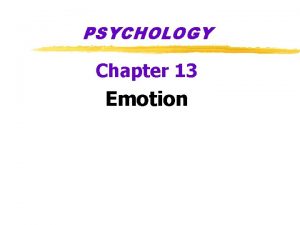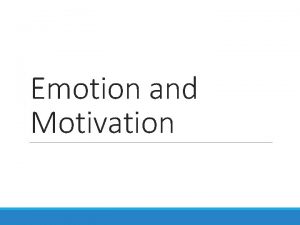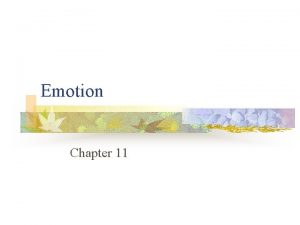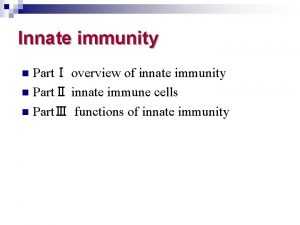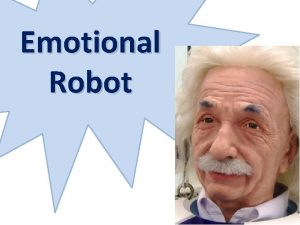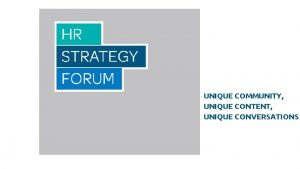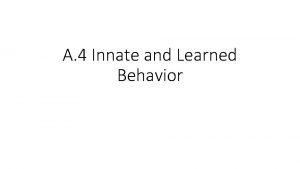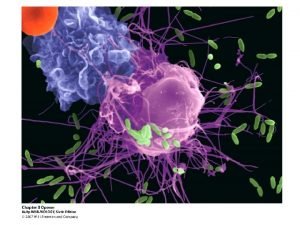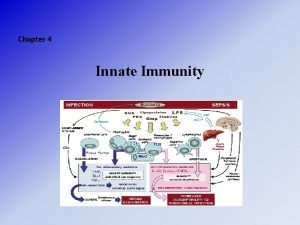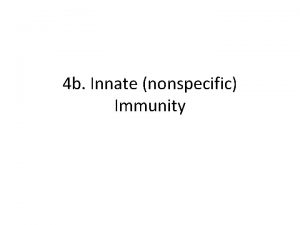Emotion Overview Innate structural versus functionalist view Unique

























































- Slides: 57

Emotion

Overview Innate structural versus functionalist view Unique brain regions Perceptually distinct Situational specificity ▪ Surprise, video examples Developmental overview Emotion socialization

Emotion n Quick and long term behavioral motivation – – – n n n Hunger-Distress-Cry Interest-Attentive face Engaging playful other – joy - smile Organize action, physiology, cognition, & perception To meet environmental and internal demands Patterns constitute core aspects of temperament/personality functioning https: //www. youtube. com/watch? v=Or 0 Zv 57 Ov. YI twins fight over toothbrush`

History n Emotions don’t exist (or can’t be studied) – n Emotional expressions are infinitely malleable – n Some anthropological accounts Emotions are things – structural accounts – – – n Behaviorism, ’ 50 s - ‘ 60 s Discrete/Differential theory, ’ 70 s – ’ 80 s Cross-cultural recognition of expressions Demonstrates hard-wiring of universal emotions? Emotions are processes and have functions – Functionalist, dynamic systems, emotion regulation, constuctivist ‘ 90 s – ’ 10 s

Universality

About Face! Infant Facial Expressions of Emotion COLE & MOORE (2015)

Infant Emotions Are infants biologically prepared to express certain emotions? Izard: Differential Emotions Theory (DET) Emotional expressions only occur as they become adaptive

Evidence for DET 1. Infant emotional responses to paradigms 2. Cross-cultural evidence 3. Newborn facial musculature 4. Fetal/non-human facial expressions 5. Congenitally blind people

Criticism Infant facial expressions: ◦Ambiguous ◦Unrelated to context ◦Rapidly changing ◦Variations of prototypical expressions

Response Facial Babbling Caregiver feedback Decoding others’ facial variability Blends of emotional Expressions

Social Construction of Emotions Caregiver expectations Infant survival Neural network development Cultural differences

Discussion How could cultural differences influence infants’ understanding and expression of emotions? How might this differ for infants who are born blind? What about children with ASD? What do you think? Do you buy any one theory more than another?

What emotions do you see here? Cohn

Facial affect program n n “There are some facial expressions of emotion that are universal. ” “why do we not press our lips tightly together when happy and curve the corners up when angry, rather than the reverse? ” • (Ekman, 1973, p. 219)

Who’s friends came to visit From Cohn

What about development?

Structuralist (discrete, natural kinds) – Emotions—unique patterns of subjective feeling, cognitive appraisal, physiological arousal, facial expressions n Basic emotions promote survival

The Structuralist View “Many models assume that each emotion kind is characterized by a distinctive syndrome of hormonal, muscular, and autonomic responses that are coordinated in time and correlated in intensity “ p. 30 Barrett, 2006

But where are specific emotions?

Key brain regions implicated in emotion-related processing.

Emotional brain - Limbic system n n Border of primitive brain stem and cortex Lower portions - visceral (bodily) feelings – n Developed at birth Limbic cortex – awareness of feeling Damasio: Emotion is a neurochemical process. Feeling is our sensation of that process

Where is joy located? n anterior cingulate cortex, ventromedial prefrontal cortex n basal ganglia involved in related action tendencies. Greater left than right cerebral activation (Duchenne smiles, tail wagging, etc), Murphy et al. , 2003

Facial affect programs? n Current evidence: – – Relevant linked brain systems But not distinct affect programs Fear may be exception Panskepp and current animal work

Structural Discrete Emotions Theory (DET) Hypotheses n n “Emotion-specific” programs unite expressive, physiological, and phenomenological processes As the CNS matures, “basic emotions emerge as structured wholes” – n don’t come together developmentally There are no display rules operating in infancy – In infancy, as discrete emotions arise, they should be accompanied by discrete facial expressions of those emotions (read-outs)

Discrete infant emotions…? Do you believe? What are our criteria for belief?

Infant negative expressions rated as distress (Oster et al. , 1992)

Negative emotional expressions are not situationally specific n Through 2 months, Justine – n shows distress to bathing, being moved, & pacifier removal (inoculation and hunger) After 2 months, anger and, to a much lesser degree, sadness are most common reaction to all negative elicitors – infants cry, not a specific reaction • Camras, 1992

Specifying Specificity: Facial Expressions at 4 Months n n evidence for a family of frustrating, goalblocking events that elicited expressions and cortisol responses indicative of anger at 4 months. Yet situations also elicited expressions and cortisol changes indicative of sadness. Bennett, David S. ; Bendersky, Margaret; Lewis, Michael Infancy. Vol 6(3), 2004, 425 -429

Specificity—intersituational & intrasituational n n n ‘Children produced more joy facial expressions in joy episodes (intersituational specificity) and more joy and surprise than other expressions in joy and surprise episodes (intrasituational specificity). But children produced anger, fear, and sadness expressions more in noncorresponding episodes and produced these expressions less than other expressions in corresponding episodes. ’ 120 7 -9 year-olds; discussions with mother – Castro, et al. (2018).

Specific elicitors discrete expressions? Expressions from specific elicitors? Sad distress smile: http: //www. youtube. com/watch? v=ak. PVt. Ob. BUOk&feature=related Fear (surprise? ) elicitor distress: https: //www. youtube. com/watch? v=ND 14 p. BQmtgo Neutral sad—distress https: //www. youtube. com/watch? v=Dx 9 Mh 8_fp. D 8

Do elicitors need to be stronger? n Maze game (fear) – – Boy: http: //www. youtube. com/watch? v=ZGd 5 Nq. P 6 qd 4 Girl: http: //www. youtube. com/watch? v=LC 5 q. Pv. TQUdo girl 0: 55 -1: 07, boy 1: 45 -2: 30: https: //poki. com/en/g/scary-maze Long: http: //www. youtube. com/watch? v=q 9 k. NCBGEyfk

Surprise! Its not in the face Covert toy switch The quintessential index of change detection in perception and cognition studies

Interest expressions as coordinative motor structures n Opening the mouth is accompanied by brow raising in infants, thus producing "surprise“ expressions in non-surprise situations. – – Raised-brow movements significantly cooccurred with head-up and/or eyes-up movements at 5 & 7 mos. Knit-brows co-occurred with eyes-down at 5 mo and head-down at 7 mo n Michel, G. F. , Camras, L. A. , & Sullivan, J. (1992). Infant interest expressions as coordinative motor structures. Infant Behavior and Development, 15(3), 347 -358.

Surprise expressions as coordinative motor structures n MO is selectively associated with raised brows – n Brow raises occurred after the onset of the MO movement, further suggesting that MO recruits raised brows. Facial criteria may be inappropriate for identifying "surprise" expressions in infants. – Camras, L. A. , Lambrecht, L. , & Michel, G. F. (1996). Infant "surprise" expressions as coordinative motor structures. Journal of Nonverbal Behavior, 20(3), 183 -195.

Surprise –basic expression or emotion socialization n Posed adult: http: //www. youtube. com/watch? v=f 4 Ayfr. M 8 Q 2 o Babies n Expression on demand: – Coordinative structure? – 100 Surprised Baby Reactions Girl and Dad homecoming 1: 05— 1: 40. n – http: //www. youtube. com/watch? v=8 Da. Kc. Kq. Vhe. E&NR=1 http: //www. youtube. com/watch? v=c. Ovt. NPljtv 0&feature=related https: //www. youtube. com/watch? v=fz 6 r. Fxfkgf. M http: //www. youtube. com/watch? v=q 5 HXl_z. J 5 po n

Functional and dynamic views n n n Emotion is not inside you. Emotions are process of changing (or maintaining) relations with environment significant to the individual. Emotions influence situation.

Functionalist theory n Emotion is the person’s attempt or readiness to establish, maintain, or change the relation between the person and the environment on matters of significance to that person (Saarni et al. , 1998). – Emotion is associated with goal-attainment, social relationships, situational appraisals, action tendencies, self-understanding, self regulation, etc.

Functions n n n n Interest Fear Anger Joy Sadness Disgust Surprise n n n n Orienting/exploration Avoidance/flight Goal removal Approach/continuation Withdrawal Expulsion Orienting

Chimpanzee “Laugh Faces” Male chimp with juvenile: https: //www. youtube. com/watch? v=Kc. COs-z. Dt-o

Chimps produce open mouth faces with and without laughter, both predominate during physical contact

Infant emotional development n n Distress is present at birth Interest and joy emerge in the first 2 mos. – n joy developing through at least 6 mos. Anger, sadness, fear differentiate after 4 m.

Emotion and Self-Development – Increases in self-awareness (2/3 yrs) leads to expression of new, more complex emotions n Self-Conscious Emotions – – Pride Guilt Shame Embarrassment

Emotion Regulation Display rules – Increased ability to understand apply social rules for display of emotion in social situations n Emotion masking – – n Primitive forms in preschool; More flexible, reasoned use in middle childhood Emotion Regulation – – Adaptive management of emotional experiences Development from other-regulation to self-regulation n Internalization of socialization experiences

Expressions become more outward directed n n n Receiving candy from a previously recalcitrant vending machine 6 -year-olds exhibited similar levels of joyful expressions with and without an experimenter 8 -year-olds exhibited weaker joyful expressions alone than in social condition – although reported levels of joy did not decline. n n Holodynski (2004) Are joy (the emotion) and expression (the smile) becoming disassociated?

Volitional regulation of smiling increases from 4 to 6 to 8 years n Modified disappointing gift paradigm – – 98 children aged 4, 6, and 8 motivated to volitionally deceive an observer by false smiling, regardless of receiving an attractive, unattractive, or no gift. 10 naïve observers judged the quality of emotion – n Children's volitional regulation of their expressions increased with age, – Which was positively associated with children's understanding of how to differentiate between emotion and expression. n n Child Dev. 2015 Mar-Apr; 86(2): 579 -97. doi: 10. 1111/cdev. 12315. Epub 2014 Nov 9. Kromm H 1, Färber M, Holodynski M. Girls did not display superior regulation than boys. Socialization more generally – – Emotion displays become more restricted Full-face to partial face - miniaturization

Halloween Candy and the problem of emotion socialization n 50 secs http: //www. youtube. com/watch? v=WOlpdd 7 y 8 MI

Expressive behavior

Dynamic systems n n Development, interaction, and (emotional) behavior are complex involving multiple interfacing/interacting constituents which produce patterns we see as pre-designed regularities A bottom-up approach – Discrete emotions as preferred states formed from the interface of multiple constituents

Dynamic systems alternative n n ‘Distress-pain, anger, sadness often seen together during crying’ Perhaps negative emotion in infancy differs in intensity - phases of crying - distress & anger, with sadness reflecting a weakening of intensity – Camras

Dynamic phenomena n n The raised brow of interest occurs with raising the head There are different interest expressions – n n Problems with top-down approaches Duchenne smiling as a muscular dynamic Joy appears to develop in time Neonatal (Duchenne) smile may emerge before happiness Importance?

Feedback loops n n Internal: Proprioceptive External: Social – n "I take smiling to be a social signal, " Messinger says. "I really think that babies are learning what joy is by sharing it with someone else. " In other words, smiling might not be so much an expression of a preexisting state as a path we take to get to that state. Why do babies smile? - Slate Magazine, Jul 1, 2010 –

Mirror Neuron System n n n Neural basis for apperception of others’ experience What you see is what you feel Research limitations – n Inter-species generalization, imaging constraints, etc But potential source of ASD affective deficits…

Relative reduced activity of pars opercularis of inferior frontal gyrus to facial expressions in ASD RH LH Figure 1 Reliable activity during imitation of emotional expressions. (a, b) Activity in bilateral pars opercularis (stronger in the right) of the inferior frontal gyrus is seen in the typically developing group (a) but not in the ASD group (b). A between-group comparison (c) revealed that this difference was significant (t 4 1. 83, P o 0. 05, corrected for multiple comparisons at the cluster level). RH, right hemisphere; LH, left hemisphere. Dapretto et al. , Nature Neuroscience 2006

Internalization model n 1. 2. 3. Three postulates describing the mechanisms involved in the development of the emotion components The processes that differentiate the appraisal and expression components are interdependent Expression signs can be used symbolically Body sensations accompanying emotions are transformed into conscious feeling Holodynski & Friedlmeier (2010). The Development of Emotions and Emotion Regulation

Emotion is not facial expression n “Happiness alone is not sufficient to produce smiles. Rather, happiness produces smiles only during social interaction. ” (Ferenandez-Dols & Ruiz-Belda, 1995, p. 1114).

Behavioral ecologists. n n n Biologically oriented ethologists attempting to explain signaling behavior across species within a framework of evolution through natural selection. Facial expressions do not reflect emotions They occur during social interaction & reflect social motives and negotiation

Behavioral ecology view n Facial displays: – – – “signify our trajectory in a given social interaction” “’social tools’ aiding the negotiation of social encounters” “specific to intent and context”
 Structural functionalism sociology definition
Structural functionalism sociology definition Social solidarity meaning
Social solidarity meaning Functionalist view on education criticism
Functionalist view on education criticism Functionalist view on divorce
Functionalist view on divorce Functionalist view of education
Functionalist view of education Functionalist view on subcultures
Functionalist view on subcultures Murdocks 4 functions of family
Murdocks 4 functions of family Modern biopsychological view of emotion
Modern biopsychological view of emotion Functionalist conflict theory
Functionalist conflict theory Interactionist theory in sports
Interactionist theory in sports Functionalist perspective on deviance
Functionalist perspective on deviance Functionalist theory
Functionalist theory What is sociology about
What is sociology about Functionalist perspective
Functionalist perspective Functionalism house
Functionalism house Davis and moore role allocation
Davis and moore role allocation Functionalism social inequality
Functionalism social inequality Importance of structural functionalism
Importance of structural functionalism Symbolic interactionism vs functionalism
Symbolic interactionism vs functionalism Functionalist theory in language learning
Functionalist theory in language learning Conflict sociological perspective
Conflict sociological perspective What is structural functionalism
What is structural functionalism Things are explantory parts of uml model
Things are explantory parts of uml model Innate behavior
Innate behavior Innate definition to kill a mockingbird
Innate definition to kill a mockingbird Repression psychology example
Repression psychology example Innate immunity first line of defense
Innate immunity first line of defense Neutrophil extracellular traps
Neutrophil extracellular traps Assis prof
Assis prof Active artificial immunity
Active artificial immunity Evil figure with a good heart
Evil figure with a good heart What is the answer
What is the answer Michael lacewing
Michael lacewing 1st line of defense immune system
1st line of defense immune system Innate wisdom vs educated stupidity movie examples
Innate wisdom vs educated stupidity movie examples Fire vs ice archetype
Fire vs ice archetype Imprinting biology examples
Imprinting biology examples Innate behavior
Innate behavior Phagocytr
Phagocytr Innate immunity first line of defense
Innate immunity first line of defense Innate immunity examples
Innate immunity examples Innate vs learned behavior
Innate vs learned behavior Friendly beast archetype
Friendly beast archetype Innate immunity
Innate immunity Defination of hypersensitivity
Defination of hypersensitivity Texture – innate property of
Texture – innate property of Innate wisdom vs educated stupidity
Innate wisdom vs educated stupidity Learned behavior biology
Learned behavior biology Is hibernation innate or learned
Is hibernation innate or learned Innate wisdom vs. educated stupidity
Innate wisdom vs. educated stupidity Lingual tonsil
Lingual tonsil Innate immunty
Innate immunty Is conscience innate or acquired
Is conscience innate or acquired Fire vs ice archetype examples in movies
Fire vs ice archetype examples in movies Difference between acquired immunity and innate immunity
Difference between acquired immunity and innate immunity Innateness theory of language
Innateness theory of language Innate immunity first line of defense
Innate immunity first line of defense Unfaithful wife archetype examples
Unfaithful wife archetype examples
